CALLICOON FINE ARTS
49 DELANCEY ST
NEW YORK, NY 10002
49 DELANCEY ST
NEW YORK, NY 10002
PRESS RELEASE
Skywiper
November 2–December 21, 2014
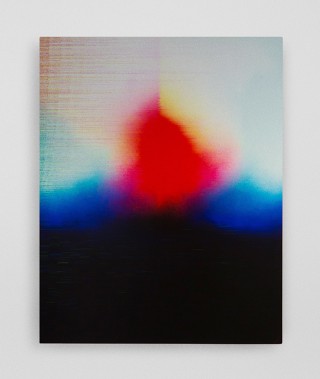
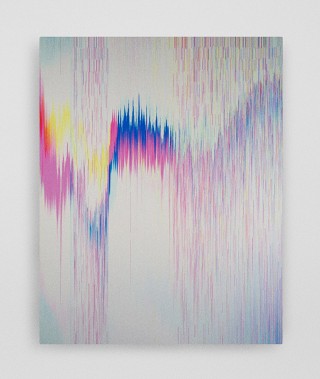
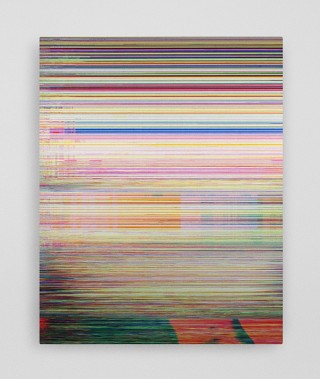
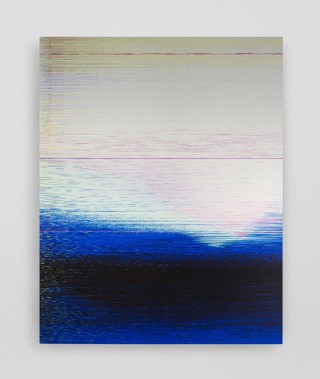
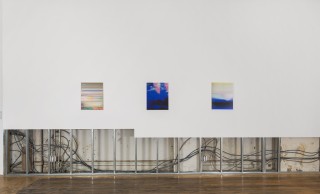
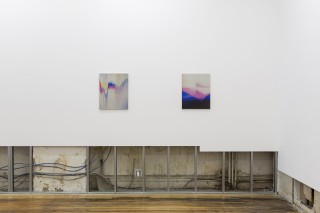
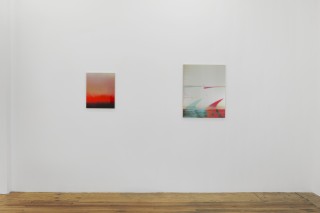

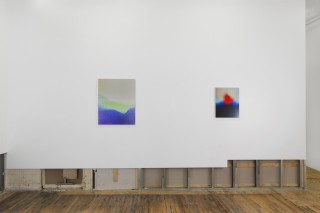
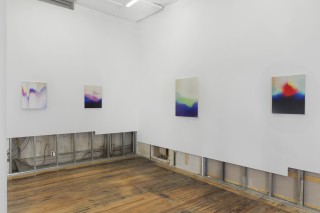

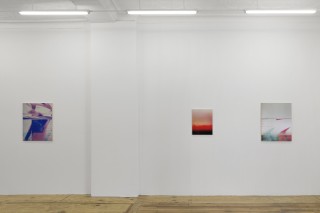
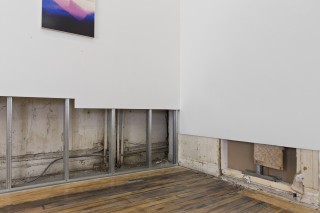
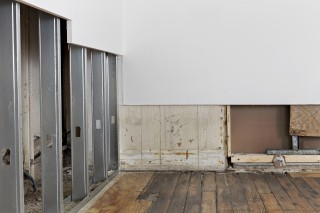
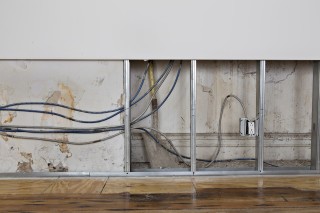


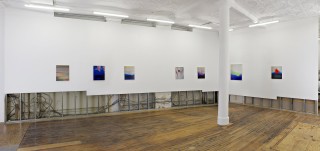
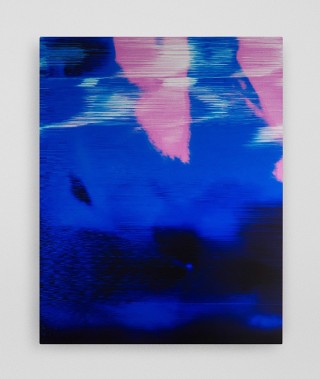
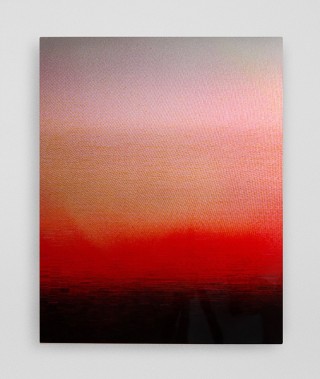
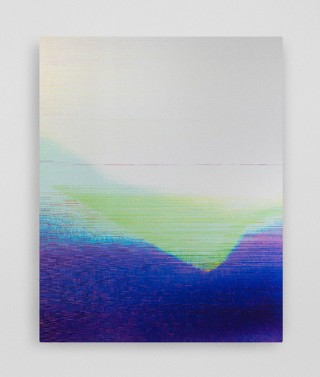
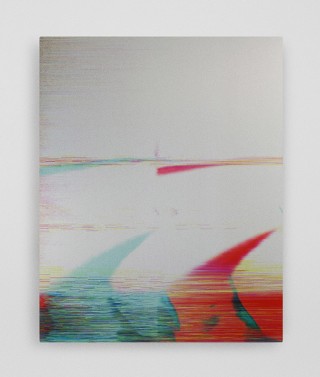
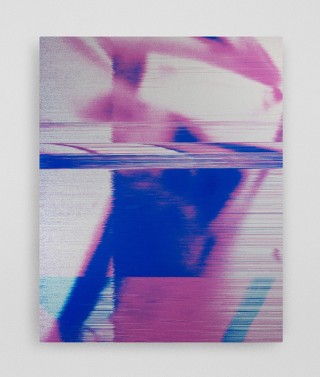
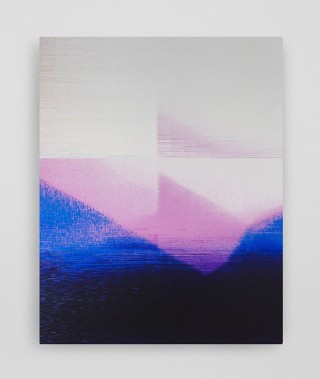
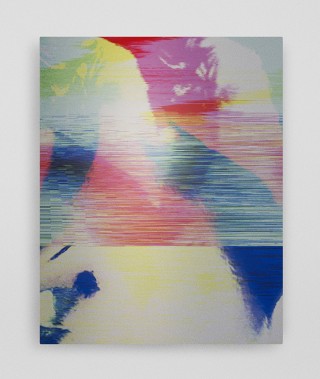
“Viruses, like art, need a host. Preferably a popular one,” says artist James Hoff, whose exhibition at Callicoon Fine Arts will be on view from November 2nd to December 21, 2014. The artworks in the exhibition are the result of infection by computer virus that finds its host in the space of painting and of the gallery.
By using code to infect forms, Hoff underscores the systematic, linguistic and distributed nature of artworks as well as the infrastructure used to support their viewing. The resulting works extend the definitions of conceptual art into the contemporary realms of interconnectivity, and their attendant threats and anxieties, offering new models for the consideration of art and art making.
Like many artists embarking on the creation of an artwork, Hoff begins with a blank surface. Digital images of blank canvas and monochromatic support surfaces are infected by a computer virus and the distorted images are then realized as new paintings through a dye sublimation process. For this exhibition Hoff uses the Stuxnet and Skywiper codes, both of which have been employed in recent years to carry out acts of cyber espionage.
The infection process produces color and form, an abstract array of thin dashes and lines embedded within the coating on the aluminum substrate. Swipes of color bleed into dense areas of pigment. These areas break down into a haze of micro-glitches, which then seem to be absorbed by other visible forms. Some of these forms move into the foreground while others recede into the background, a landscape that merges into invisibility.
In addition to the paintings, virus infection is used to alter the exhibition space itself. Hoff removes sections of dry wall whose shape is determined by the glitch caused by the virus in a jpeg image of the gallery wall. What this removal reveals, however, is not just what lies behind the wall, but also the dysfunctional fusion of corporeal experience and computational space.
The exhibition parallels the release of Hoff’s critically acclaimed album by the Berlin-based PAN records. Hoff used the Blaster virus to infect 808 beats and then uses the mutated results as building blocks for seven highly danceable new compositions. Also this year, Hoff produced with Printed Matter an altered reprint of Russell Arundel’s Everybody’s Pixillated (1937), which served as the starting point of his exhibition at the gallery in 2012. Treating the book as a carrier device, Hoff concealed a 170 million-word password/cracking dictionary (via a micro SD card) in the back cover.
Currently, a painting by James Hoff illustrates the front cover of the Fall 2014 issue of BOMB Magazine. The issue contains an interview with the artist. His work has been featured in a two-person exhibition at Kunsthall Oslo, and was included in Postscript: Writing After Conceptual Art (Museum of Contemporary Art Denver, The Broad Art Museum, East Lansing, MI, and The Power Plant, Toronto). His work has also been included in group exhibitions at IMO, Copenhagen, Printed Matter, Foxy Production, Lisa Cooley and Bureau, all New York, as well as at Air De Paris in Paris.
By using code to infect forms, Hoff underscores the systematic, linguistic and distributed nature of artworks as well as the infrastructure used to support their viewing. The resulting works extend the definitions of conceptual art into the contemporary realms of interconnectivity, and their attendant threats and anxieties, offering new models for the consideration of art and art making.
Like many artists embarking on the creation of an artwork, Hoff begins with a blank surface. Digital images of blank canvas and monochromatic support surfaces are infected by a computer virus and the distorted images are then realized as new paintings through a dye sublimation process. For this exhibition Hoff uses the Stuxnet and Skywiper codes, both of which have been employed in recent years to carry out acts of cyber espionage.
The infection process produces color and form, an abstract array of thin dashes and lines embedded within the coating on the aluminum substrate. Swipes of color bleed into dense areas of pigment. These areas break down into a haze of micro-glitches, which then seem to be absorbed by other visible forms. Some of these forms move into the foreground while others recede into the background, a landscape that merges into invisibility.
In addition to the paintings, virus infection is used to alter the exhibition space itself. Hoff removes sections of dry wall whose shape is determined by the glitch caused by the virus in a jpeg image of the gallery wall. What this removal reveals, however, is not just what lies behind the wall, but also the dysfunctional fusion of corporeal experience and computational space.
The exhibition parallels the release of Hoff’s critically acclaimed album by the Berlin-based PAN records. Hoff used the Blaster virus to infect 808 beats and then uses the mutated results as building blocks for seven highly danceable new compositions. Also this year, Hoff produced with Printed Matter an altered reprint of Russell Arundel’s Everybody’s Pixillated (1937), which served as the starting point of his exhibition at the gallery in 2012. Treating the book as a carrier device, Hoff concealed a 170 million-word password/cracking dictionary (via a micro SD card) in the back cover.
Currently, a painting by James Hoff illustrates the front cover of the Fall 2014 issue of BOMB Magazine. The issue contains an interview with the artist. His work has been featured in a two-person exhibition at Kunsthall Oslo, and was included in Postscript: Writing After Conceptual Art (Museum of Contemporary Art Denver, The Broad Art Museum, East Lansing, MI, and The Power Plant, Toronto). His work has also been included in group exhibitions at IMO, Copenhagen, Printed Matter, Foxy Production, Lisa Cooley and Bureau, all New York, as well as at Air De Paris in Paris.
CALLICOON FINE ARTS
49 DELANCEY ST
NEW YORK, NY 10002
49 DELANCEY ST
NEW YORK, NY 10002
PRESS RELEASE
Skywiper
November 2–December 21, 2014

























“Viruses, like art, need a host. Preferably a popular one,” says artist James Hoff, whose exhibition at Callicoon Fine Arts will be on view from November 2nd to December 21, 2014. The artworks in the exhibition are the result of infection by computer virus that finds its host in the space of painting and of the gallery.
By using code to infect forms, Hoff underscores the systematic, linguistic and distributed nature of artworks as well as the infrastructure used to support their viewing. The resulting works extend the definitions of conceptual art into the contemporary realms of interconnectivity, and their attendant threats and anxieties, offering new models for the consideration of art and art making.
Like many artists embarking on the creation of an artwork, Hoff begins with a blank surface. Digital images of blank canvas and monochromatic support surfaces are infected by a computer virus and the distorted images are then realized as new paintings through a dye sublimation process. For this exhibition Hoff uses the Stuxnet and Skywiper codes, both of which have been employed in recent years to carry out acts of cyber espionage.
The infection process produces color and form, an abstract array of thin dashes and lines embedded within the coating on the aluminum substrate. Swipes of color bleed into dense areas of pigment. These areas break down into a haze of micro-glitches, which then seem to be absorbed by other visible forms. Some of these forms move into the foreground while others recede into the background, a landscape that merges into invisibility.
In addition to the paintings, virus infection is used to alter the exhibition space itself. Hoff removes sections of dry wall whose shape is determined by the glitch caused by the virus in a jpeg image of the gallery wall. What this removal reveals, however, is not just what lies behind the wall, but also the dysfunctional fusion of corporeal experience and computational space.
The exhibition parallels the release of Hoff’s critically acclaimed album by the Berlin-based PAN records. Hoff used the Blaster virus to infect 808 beats and then uses the mutated results as building blocks for seven highly danceable new compositions. Also this year, Hoff produced with Printed Matter an altered reprint of Russell Arundel’s Everybody’s Pixillated (1937), which served as the starting point of his exhibition at the gallery in 2012. Treating the book as a carrier device, Hoff concealed a 170 million-word password/cracking dictionary (via a micro SD card) in the back cover.
Currently, a painting by James Hoff illustrates the front cover of the Fall 2014 issue of BOMB Magazine. The issue contains an interview with the artist. His work has been featured in a two-person exhibition at Kunsthall Oslo, and was included in Postscript: Writing After Conceptual Art (Museum of Contemporary Art Denver, The Broad Art Museum, East Lansing, MI, and The Power Plant, Toronto). His work has also been included in group exhibitions at IMO, Copenhagen, Printed Matter, Foxy Production, Lisa Cooley and Bureau, all New York, as well as at Air De Paris in Paris.
By using code to infect forms, Hoff underscores the systematic, linguistic and distributed nature of artworks as well as the infrastructure used to support their viewing. The resulting works extend the definitions of conceptual art into the contemporary realms of interconnectivity, and their attendant threats and anxieties, offering new models for the consideration of art and art making.
Like many artists embarking on the creation of an artwork, Hoff begins with a blank surface. Digital images of blank canvas and monochromatic support surfaces are infected by a computer virus and the distorted images are then realized as new paintings through a dye sublimation process. For this exhibition Hoff uses the Stuxnet and Skywiper codes, both of which have been employed in recent years to carry out acts of cyber espionage.
The infection process produces color and form, an abstract array of thin dashes and lines embedded within the coating on the aluminum substrate. Swipes of color bleed into dense areas of pigment. These areas break down into a haze of micro-glitches, which then seem to be absorbed by other visible forms. Some of these forms move into the foreground while others recede into the background, a landscape that merges into invisibility.
In addition to the paintings, virus infection is used to alter the exhibition space itself. Hoff removes sections of dry wall whose shape is determined by the glitch caused by the virus in a jpeg image of the gallery wall. What this removal reveals, however, is not just what lies behind the wall, but also the dysfunctional fusion of corporeal experience and computational space.
The exhibition parallels the release of Hoff’s critically acclaimed album by the Berlin-based PAN records. Hoff used the Blaster virus to infect 808 beats and then uses the mutated results as building blocks for seven highly danceable new compositions. Also this year, Hoff produced with Printed Matter an altered reprint of Russell Arundel’s Everybody’s Pixillated (1937), which served as the starting point of his exhibition at the gallery in 2012. Treating the book as a carrier device, Hoff concealed a 170 million-word password/cracking dictionary (via a micro SD card) in the back cover.
Currently, a painting by James Hoff illustrates the front cover of the Fall 2014 issue of BOMB Magazine. The issue contains an interview with the artist. His work has been featured in a two-person exhibition at Kunsthall Oslo, and was included in Postscript: Writing After Conceptual Art (Museum of Contemporary Art Denver, The Broad Art Museum, East Lansing, MI, and The Power Plant, Toronto). His work has also been included in group exhibitions at IMO, Copenhagen, Printed Matter, Foxy Production, Lisa Cooley and Bureau, all New York, as well as at Air De Paris in Paris.